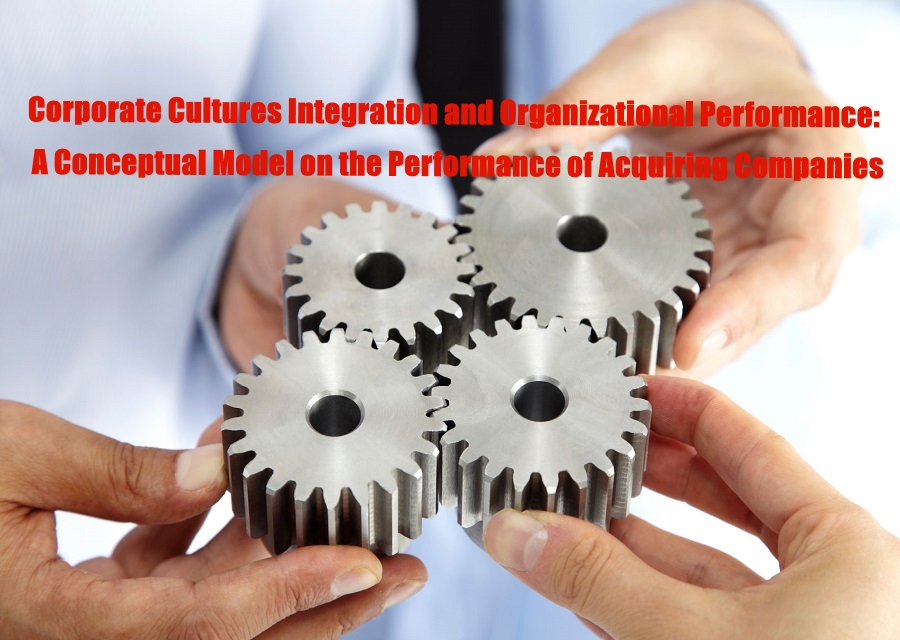Corporate Cultures Integration and Organizational Performance: A Conceptual Model on the Performance of Acquiring Companies
Abstract
Mergers and Acquisitions (M&A) is one of the corporate strategies for companies to achieve better performance. However, it have been reported that many companies fail to meet the expected synergy value. Through an extensive review of related literatures and interview with key executives experienced with M&A, corporate cultures integration has been identified as a critical factor in success and failure of M&A exercises. A conceptual model was developed to describe its relationship with organizational performance. This research contributes to the existing literatures and the findings will be useful for top management to design the corporate cultures strategically for better performance.
Introduction Mergers and Acquisitions (M&A) is one of the corporate strategies for companies to achieve better performance and possibly making profit. However, it has been reported that many companies fail to meet the expected synergy value and it takes longer time to achieve better performance. According to KPMG research in M&A analysis, 83% of M&A deals fail and these deals had not boosted shareholder returns, while a separate research by Kearney (2012) concluded that total returns on M&A were negative (Heffernan, 2012). Hence, emergence of research interests has been conducted to investigate the factor of success and reason of why M&A often fail, but it was ending up with conflicting findings (Mohibullah, 2009; Stahl & Voigt, 2005; Stahl & Voigt, 2008; King, Dalton, Daily & Covin, 2004; Weber & Tarba, 2010). In Malaysia, M&A exercise has contributed to accelerate one of the objectives of Economic Transformation Programme (ETP). ETP is an initiative by the Malaysian government to turn Malaysia into a high income economy by 2020 (Najib, 2012). Malaysia has been continuously become the highest ranking in M&A activities for the years of 2005, 2006 and 2007 with each total deal value of USD13.08 billion, USD28.24 billion and USD44.06 billion respectively (Bursa, 2013). However, many of acquiring companies faced decline in their sales growth for the first 3 to 5 years that shows the performance has not been impressive after M&A activities (Bursa, 2013). There is increasing evidence that cultural clashes are the main reason of poor performance as well as timeconsuming conflicts in the integration of two or more companies (Appelbaum, Lefrancois, Tonna, & Shapiro, 2007; Mohibullah, 2009; Nguyen & Kleiner, 2003; Stahl & Voigt, 2005; Stahl & Voigt, 2008). There are many researches have been examining the relationship of corporate culture and its influence to M&A success and failure such as in European chemical industry (Lodorfos & Boateng, 2006), in USA (Runge & Hames, 2004) that investigated the perceived cultural compatibility index as well as Veiga, Lubatkin, Calori and Very (2000) that measuring organizational culture clashes in European M&A. All of these studies revealed positive relationship of organizational culture and organizational performance of companies that have experience M&A exercises. Also, these studies suggested future research should focus on companies that experienced M&A activities from cross section industries. Since these previous studies were based on western data, therefore might not be transferable or applicable to Malaysian society which is based on collectivist and high power distance values (Ahmad & Aafaqi, 2004; Hofstede, 1998). As for these reasons, this research moves the current knowledge frontier to investigate the corporate culture integration in M&A context in a non-western country, namely Malaysia.
2.Literature Review
2.1 Reasons of Failure in M&A
According to Appelbaum, Gandell, Yortis, Proper and Jobin (2000) many of M&A have only been evaluated based on their compatibility regarding financial figures, technological advantages, or market share, very few had focused on the soft or intangible M&A issues. People issues once were considered soft issues, but organizations have learned there are hard consequences to ignore or mismanage people issues during a deal (Appelbaum et.al., 2000; Appelbaum, Lefrancois, Tonna, & Shapiro, 2007). Research, however, indicates that people issues occur in several phases of M&A activity. More specifically, people issues in just the integration phase of M&A include retention of key talent, communications, and integration of corporate cultures (Appelbaum et.al., 2000; Appelbaum et al., 2007; Charman, 1999; Mohibullah, 2009). These are supported by other authors (Lodorfos & Boateng, 2006; Stahl & Voigt, 2005) that argued culture clashes, gaps, or incompatibility during integration phase are the most frequent reasons of M&A failure. While these cultural issues are important in M&A activity throughout the world, their importance tends to vary by the type of M&A combination. For example, if it is an acquisition that will allow for separation of the acquired company, there may be fewer evaluation, selection, and replacement decisions than in acquisitions that result in complete integration of the two companies (Jackson and Schuler, 2001; Weber & Tarba, 2010). Moreover, once a business has decided to undertake M&A, one of the most crucial tasks is the combination of the two or more workforces into one. The task of cultural assessment and integration are critical and become continuous process that supports the whole M&A (Appelbaum et al., 2007; Lodorfos & Boateng, 2006; Mohibullah, 2009; Stahl & Voigt, 2008). Therefore the integration of cultures of the two or more companies could improve performance. Thus, this research attempts to examine the influence of corporate cultures integration on the performance of acquiring companies in Malaysia which can be beneficial to the new corporate entity that have experienced M&A exercises in attaining positive business performance.
2.2. Performance of Acquiring Companies
An extensive body of literature has investigated the variables that measure the performance of acquiring companies. The evidence indicates that there is no clear relationship between performance and such financial and strategic variables as the level of relatedness (King et al., 2004; King, 1997). However, according to previous studies (Stahl & Voigt, 2005; Zollo & Meier, 2008), subjective measurements have focused on degrees of synergy realization, integration effectiveness and of strategic gap reduction while objective measurements use accounting performance, market performance and other operational data. Furthermore, according to these authors (Zollo & Meier, 2008), the time horizon used vary from short term (around the announcement date) to long term (up to five years after completing the acquisition). Stahl and Voigt (2005) have done a comprehensive critical research review on the impact of cultural differences on M&A performance. They found that socio-cultural integration based measures, voluntary turnover and stress can be considered as an important dimension of M&A success and failure. As for this research, the socio-cultural integration based measures will be assessed in determining the performance of acquiring companies in the post-M&A phase. The dimension of socio cultural integration will be adapted from Okoro (2010) that has examined the relationship between organizational culture and performance of M&A in the Nigerian banking studies. The research confirmed the positive relationship between an employee’s perception of cultural traits integration and resultant organizational performance.
2.3. The Importance of Culture in M&A
Corporate strategy like M&A is very complex and challenging process as it involved major changes from many aspects including management of employees. Its effects on employees through this trying time are critical and significantly influences the adoption of a new culture, the change process itself, and the level of stress employees can experience (Appelbaum et al., 2000; Applebaum et al., 2007; Stahl & Voigt, 2005; Stahl & Voigt, 2008). It is believed that corporate culture has a positive and significant effect on organizational performance in ensuring M&A success as most of the global changes like M&A have impacted the human behavior in the organization. However, few empirical researches have been carried out to comprehensively explain factors focusing on the corporate culture towards organizational performance of acquiring companies. As for Malaysia, no research has been documented to date even Malaysia has seen heavy M&A activities over the past years. In this research, the Competing Values Framework (CVF) developed by Cameron & Quinn (2006) will be used in constructing a corporate culture integration profile. CVF is one of the most influential and extensively used models in the area of organizational culture research. Compared with other models and scales, the CVF and its matched scale namely Organizational Culture Assessment Instrument (OCAI), have better validity and reliability and are very convenient for practical operations (Carroll, 2008; Whitaker, 2011; Yu & Wu, 2009). Through the use of the OCAI, an organizational culture profile can be drawn by establishing the organization’s dominant culture type characteristics through a self-reported survey method.
2.4. A Proposed Conceptual Model
The suggested conceptual model shows the relationship between corporate cultures integration and performance of acquiring companies. The model recommends that the corporate cultures integration influence the performance of acquiring companies. The theoretical perspective employed is based on Competing Values Framework (Cameron & Quinn, 2006).
2.5. Corporate cultures integration and performance of acquiring companies
Many M&A fail because of a lack of methodical and thorough measurement of culture differences (Weber and Tarba, 2010). The evaluation of corporate cultures integration of companies that have involved in M&A activities is a complex task. Researchers have found a positive correlation between corporate cultures integration and performance of acquiring companies (Mohibullah, 2009; Stahl & Voigt, 2005; Weber & Drori, 2008). This research will examine the relationship between corporate cultures integration and performance of acquiring companies using dimensions proposed by Cameron and Quinn (2006) namely, dominant characteristics, organizational leadership, management of employees, organization glue, strategic emphases and criteria for success. Therefore, it is postulated that there is a positive and significant relationship between the corporate cultures integration that emphasizes on these six dimensions and the performance of acquiring companies in Malaysia.
3.Conclusion
From the preliminary research, it can be concluded that companies should put the best people in charge of implementing M&A deals. More emphasis needs to be placed on early planning of the integration process. It is believed that corporate cultures integration is the most important activity for successful M&A integration. The research is expected to contribute significantly to the body of knowledge concerning M&A decision in Malaysia. As the country is looking for new sources of economic growth, it is hoped that the findings would be able to provide a foundation theory of new corporate companies specifically in post M&A phase as well as companies that decide to undertake M&A decision so that early planning can be strategized earlier for better performance (Syazliana, 2013). In terms of theoretical significance, this research proposes to fill the gap in the body of knowledge of corporate cultures integration specifically in the M&A context in Malaysia. Meanwhile, for practical contribution, the findings of this research will be useful to top management and practitioners to design their corporate cultures integration within a strategic condition at the micro or macro organizational level in order to improve M&A performance, specifically to optimize efficiency in managing post M&A phase successfully.



Leave A Comment